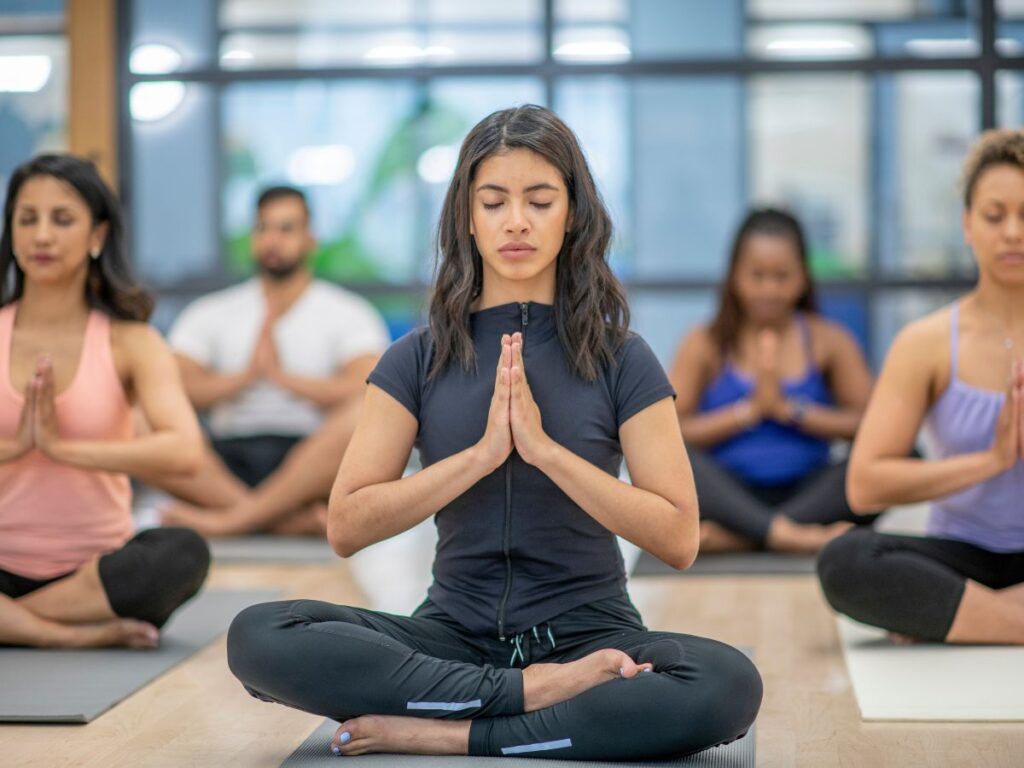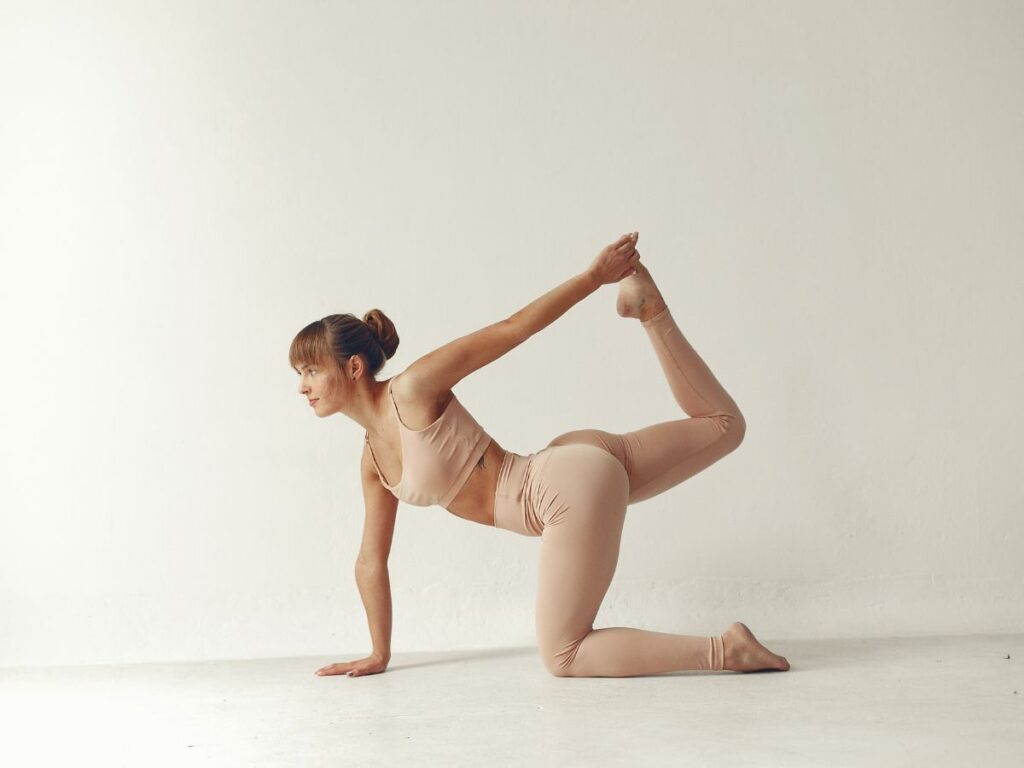Basic Principles of Yoga
Yoga Postures, Benefits and Concepts – Man has been interested in himself since time immemorial, and in this journey of self-knowledge, he has come to discover many secrets. Numerous sciences have emerged due to his efforts. Thousands of years ago, humans in the subcontinent studied themselves in such a way that they gained extensive information not only about their physical selves but also their spiritual aspects. In the light of this knowledge, the foundation of profound disciplines like yoga was laid.

Yoga involves the study of the mental, physical, and spiritual thoughts and movements of man, with formulated methods aimed at improving them. The fundamental principles of yoga consist of eight stages of success.
Yama (Ethical Principles):
Involves moral guidelines and ethical conduct, including non-violence (Ahimsa), truthfulness (Satya), non-stealing (Asteya), chastity (Brahmacharya), and non-possessiveness (Aparigraha).
Niyama (Personal Observances):
Focuses on self-discipline and spiritual observances, encompassing purity (Saucha), contentment (Santosha), self-discipline (Tapas), self-study (Svadhyaya), and surrender to a higher power (Ishvara Pranidhana).
Asana (Physical Postures):
Involves the practice of physical postures and poses, promoting strength, flexibility, and balance in the body.
Pranayama (Breath Control):
Focuses on breath regulation and control, emphasizing the connection between breath and the mind.
Pratyahara (Withdrawal of the Senses):
Involves turning the attention inward, away from external stimuli, to achieve a state of inner focus and concentration.
Dharana (Concentration):
Concentrating the mind on a single point or object to cultivate mental focus.
Dhyana (Meditation):
Involves sustained concentration and focus, leading to a state of meditation and heightened awareness.
Samadhi (Union):
The ultimate stage of yoga, where the practitioner experiences a profound state of oneness, transcendence, and spiritual realization.
Yoga Postures and Mudras
Various asanas and mudras are practiced in yoga exercises. Each asana and mudra has different effects.
Asana
Different postures in yoga are referred to as asanas. Asanas are also known as yoga postures.
Mudra
Hand postures in yoga are called mudras. The principle behind the knowledge of mudra is that humans are not only an important part of the universe but also contain all the five basic elements found in the universe, each with its own effects. These five basic elements are fire, air, sky, earth, and water.
According to the knowledge of Mudra, the root cause of any disease in the human body is an imbalance in these elements. Therefore, correcting the balance of these elements can lead to complete recovery from the disease. According to this understanding, human health is within one’s grasp. Each finger represents an element that, when used properly in mudra form, can restore elemental balance in the body.
In Yoga, it is believed that the fingers and thumbs of the hand constantly emit electrical charges. By combining them in a specific way, it is possible to control their representative element and eliminate any disease.

What is yoga and the benefits?
Yoga is a holistic practice that originated in ancient India and encompasses physical, mental, and spiritual elements. It involves a combination of physical postures (asanas), breath control (pranayama), meditation, and ethical principles. The word “yoga” itself means union, signifying the harmonious integration of mind, body, and spirit.
Benefits of Yoga:
Improved Flexibility:
Regular practice of yoga helps enhance flexibility by stretching and lengthening muscles.
Increased Strength:
Many yoga postures require the use of body weight as resistance, leading to improved strength and muscle tone.
Stress Reduction:
Yoga emphasizes mindfulness and relaxation techniques, which can reduce stress levels and promote a sense of calm.
Enhanced Respiratory Function:
Pranayama, or breath control, is a fundamental aspect of yoga. It can improve lung capacity and respiratory efficiency.
Better Posture:
Yoga helps to develop awareness of body alignment, leading to improved posture and reduced strain on the spine.
Mental Clarity and Focus:
The combination of physical movement and mindfulness in yoga can enhance concentration and mental clarity.
Emotional Well-being:
Yoga encourages self-awareness and introspection, fostering emotional stability and a positive outlook on life.
Balance and Coordination:
Yoga postures often involve balance, which can help improve overall coordination and stability.
Pain Relief:
Yoga may alleviate chronic pain conditions, such as lower back pain, arthritis, and headaches, through improved flexibility and relaxation.
Boosted Immune System:
Regular practice of yoga has been linked to a strengthened immune system, promoting overall health and well-being.
Increased Energy Levels:
Yoga stimulates the flow of energy throughout the body, reducing fatigue and boosting vitality.
Mind-Body Connection:
Yoga encourages the connection between physical movements and mental states, promoting a holistic approach to health.
It’s important to note that individual experiences with yoga may vary, and the benefits can depend on factors such as the type of yoga practiced, frequency, and the individual’s health condition. Whether practiced for physical fitness, stress relief, or spiritual growth, yoga offers a diverse range of benefits for people of all ages and fitness levels.

What Is the Concept of Yoga?
The concept of yoga is rooted in ancient Indian philosophy and encompasses a holistic approach to well-being, encompassing the physical, mental, and spiritual dimensions of life. The word “yoga” is derived from the Sanskrit word “yuj,” which means to unite or yoke.
The primary aim of yoga is to achieve a harmonious union of the individual self (atman) with the universal consciousness (Brahman). While there are various paths and schools of yoga, they all share common principles and objectives.
Key Concepts of Yoga:
Union and Harmony:
The fundamental concept of yoga is the union of the individual soul with the universal spirit. This union is often described as the realization of one’s true nature and the interconnectedness of all beings.
Pathways to Unity:
There are different paths (or limbs) of yoga that cater to various aspects of human existence. The classical text “Yoga Sutras” by Patanjali outlines these paths, including Raja Yoga (the path of meditation), Bhakti Yoga (the path of devotion), Karma Yoga (the path of selfless action), and Jnana Yoga (the path of knowledge).
Physical and Mental Well-being:
While yoga involves spiritual elements, it also addresses the physical and mental dimensions of life. The practice of physical postures (asanas) and breath control (pranayama) contributes to physical health and mental clarity.
Mindfulness and Awareness:
Yoga places a strong emphasis on mindfulness and self-awareness. Practitioners are encouraged to be present in the moment, observing their thoughts and sensations without attachment or judgment.
Ethical Guidelines:
The practice of yoga is accompanied by ethical guidelines known as the Yamas and Niyamas. These include principles such as non-violence (ahimsa), truthfulness (satya), non-attachment (aparigraha), and contentment (santosha).
Balance and Harmony in Life:
Yoga seeks to establish a sense of balance in all aspects of life. This includes finding equilibrium between activity and rest, work and leisure, and various other dualities.
Inner Transformation:
Yoga is not just a physical exercise but a transformative journey. It encourages self-discovery, personal growth, and the overcoming of obstacles on the path to self-realization.
Universal Connection:
Yoga recognizes the interconnectedness of all living beings and promotes compassion and empathy. Practitioners strive to cultivate a sense of unity and universal love.
Meditation and Contemplation:
Yoga involves practices of meditation and contemplation to quiet the mind, attain inner peace, and connect with the deeper aspects of consciousness.
The concept of yoga goes beyond the confines of a mere physical exercise routine; it is a holistic philosophy that aims to bring about a profound transformation in the individual, fostering a sense of well-being, inner peace, and a connection to the greater whole.

How To Start Doing Yoga?
Starting yoga can be a rewarding journey for both your physical and mental well-being. Here’s a step-by-step guide to help you begin practicing yoga:
Set Clear Intentions:
- Identify your reasons for starting yoga. Whether it’s for physical fitness, stress relief, flexibility, or spiritual growth, having clear intentions will guide your practice.
Choose the Right Type of Yoga:
- Explore different styles of yoga to find one that suits your preferences and goals. Common styles include Hatha, Vinyasa, Ashtanga, Bikram, and more. Beginners often find Hatha or Vinyasa classes accessible.
Start with Basic Poses (Asanas):
- Begin with foundational yoga poses. Simple poses like Mountain Pose (Tadasana), Downward Dog (Adho Mukha Svanasana), and Child’s Pose (Balasana) are great for beginners.
Learn Proper Alignment:
- Focus on proper alignment to prevent injuries. Consider taking classes from a qualified instructor, either in-person or through online tutorials, to learn correct postures and techniques.
Practice Regularly:
- Consistency is key in yoga. Start with shorter sessions, like 15 to 30 minutes, and gradually increase the duration as your stamina improves.
Listen to Your Body:
- Pay attention to your body and its limitations. Avoid pushing yourself too hard, especially as a beginner. Modify poses if needed and gradually progress.
Use Props:
- Props like blocks, straps, and bolsters can assist in achieving proper alignment and provide support during certain poses. They’re particularly helpful for beginners.
Combine Asanas with Breathing (Pranayama):
- Incorporate breath awareness into your practice. Learning to synchronize movement with breath enhances the meditative aspect of yoga. Practice basic breathing exercises like diaphragmatic breathing.
Explore Meditation:
- Begin with short meditation sessions to calm the mind. Meditation is an integral part of yoga, contributing to mental clarity and relaxation.
Join a Class or Use Online Resources:
- Consider attending a local yoga class or joining online platforms that offer beginner-friendly sessions. A teacher can provide guidance and correct your form.
Create a Comfortable Space:
- Dedicate a quiet and comfortable space for your practice. Having a consistent environment will help create a routine.
Invest in Basic Yoga Gear:
- Purchase a yoga mat and comfortable clothing suitable for movement. As you progress, you may choose to add props and accessories.
Stay Patient and Positive:
- Yoga is a journey, and progress may be gradual. Celebrate small achievements and be patient with yourself. Avoid comparing your practice to others.
Listen to Your Inner Self:
- Yoga is not just about physical postures; it’s also about self-awareness. Listen to your inner self and honor the holistic aspects of the practice.
Remember that everyone’s yoga journey is unique. Enjoy the process, and over time, you’ll likely discover the physical, mental, and spiritual benefits that yoga can bring to your life.

What Yoga Is Best For?
Yoga offers a wide range of physical, mental, and spiritual benefits, making it suitable for various purposes and individuals. Here are some common reasons people practice yoga and the corresponding benefits:
Physical Fitness:
- Yoga Type: Vinyasa, Ashtanga, Power Yoga
- Benefits: Improves strength, flexibility, balance, and overall cardiovascular health. Promotes weight loss and tones muscles.
Stress Reduction:
- Yoga Type: Hatha, Restorative, Yin
- Benefits: Encourages relaxation, reduces cortisol (stress hormone) levels, and promotes a sense of calm. Incorporates breathing techniques to manage stress.
Flexibility and Mobility:
- Yoga Type: Hatha, Iyengar, Yin
- Benefits: Increases joint flexibility, stretches muscles, and enhances overall range of motion. Can be beneficial for individuals with stiffness or limited mobility.
Mental Clarity and Focus:
- Yoga Type: Kundalini, Jnana, Raja
- Benefits: Enhances concentration, mental clarity, and mindfulness. Meditation practices within these types can improve cognitive function.
Injury Rehabilitation:
- Yoga Type: Gentle, Restorative, Therapeutic Yoga
- Benefits: Provides a gentle approach to recovery, promotes healing, and improves flexibility. Adaptable for various injuries or health conditions.
 Anxiety and Depression Management:
Anxiety and Depression Management:
- Yoga Type: Mindful Yoga, Kundalini, Hatha
- Benefits: Incorporates breathwork and meditation to alleviate symptoms of anxiety and depression. Promotes emotional well-being.
Prenatal and Postnatal Health:
- Yoga Type: Prenatal Yoga, Postnatal Yoga
- Benefits: Supports physical health during pregnancy, eases discomfort, and promotes relaxation. Postnatal yoga helps in regaining strength and relieving stress.
Spiritual Exploration:
- Yoga Type: Bhakti, Karma, Jnana
- Benefits: Encourages self-discovery, inner exploration, and connection with a higher consciousness. Fosters a sense of purpose and meaning.
Bettered Sleep Quality
- Yoga Type Restorative, Yin
- Benefits Calms the nervous system, reduces stress, and promotes relaxation, contributing to more sleep quality.
Weight Management
- Yoga Type Power Yoga, Vinyasa, Ashtanga
- Benefits Enhances metabolism, promotes calorie burning, and contributes to weight loss. Encourages a aware approach to eating.
Heart Health
- Yoga Type Hatha, Restorative
- Benefits Lowers blood pressure, reduces cholesterol situations, and improves overall cardiovascular health. Promotes relaxation and stress reduction.
Tone- Reflection and awareness
- Yoga Type awareness Yoga, Hatha
- Benefits Encourages tone- mindfulness, tone- acceptance, and awareness. Supports growth and a deeper connection with oneself.
 It’s important to note that the benefits of yoga are connected, and individualities may witness a combination of physical, internal, and spiritual advancements. The choice of yoga type depends on pretensions, preferences, and individual health considerations. Always consult with a healthcare professional before starting a new exercise or yoga routine, especially if you have pre-existing health conditions.
It’s important to note that the benefits of yoga are connected, and individualities may witness a combination of physical, internal, and spiritual advancements. The choice of yoga type depends on pretensions, preferences, and individual health considerations. Always consult with a healthcare professional before starting a new exercise or yoga routine, especially if you have pre-existing health conditions.


